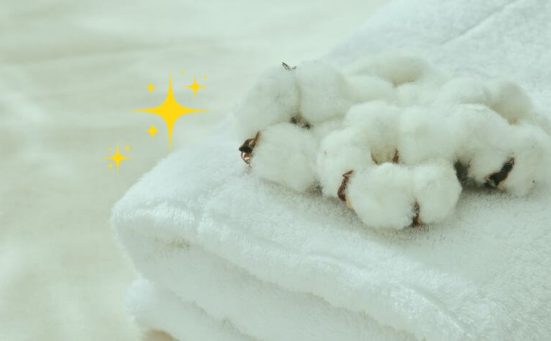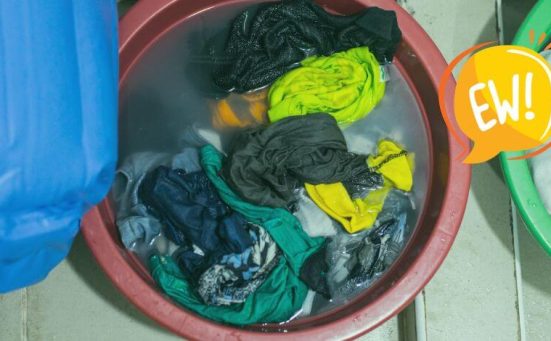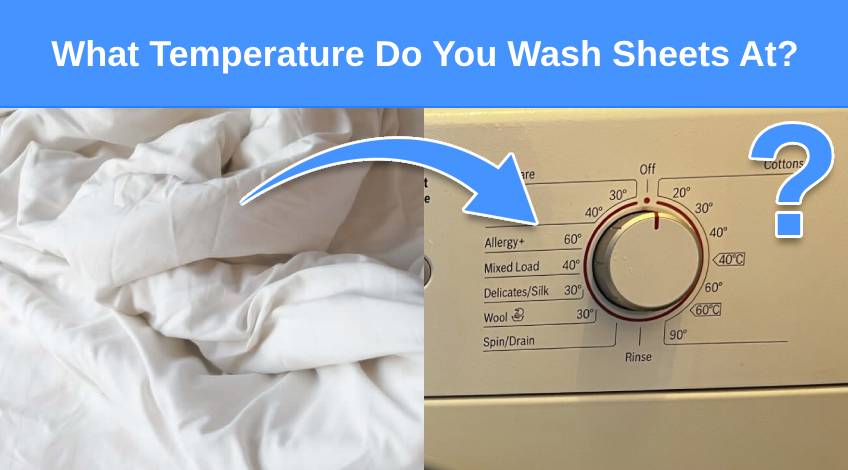
What Temperature Do You Wash Sheets At?
When it comes to the daily essentials in your home, sheets are right at the top of the list. We spend a third of our lives nestled between them, and, let’s be honest, they can get pretty dirty.
You might be wondering, “What temperature should I wash my sheets at?”
Among fabrics that we use daily, sheets are generally recommended to be washed in high temperatures around 60°C. This is because they often contain bacteria and other organic matter that will require heat to kill and remove.
But this is not always the case!
The Best Temperature For Washing Sheets
Sheets are like magnets for all sorts of things we’d rather not think about. Dust, oils, sweat, and even bacteria can find their way into your cosy bed linens.
To combat this, the best temperature for washing your sheets is a hot wash at 60°C. This temperature is perfect for killing bacteria and germs that may already be multiplying on the fabric.

A hot wash, coupled with a long wash cycle, ensures your sheets get a thorough cleaning. It’s the equivalent of a spa day for your bedding! In fact, research shows that hot washes effectively kill off bacteria and germs, which can accumulate on your sheets over time[1].
However, here’s a gentle reminder: not all sheets can handle the heat. Some fabrics will shrink or become damaged at high temperatures. So, always check your sheet’s care label, and when in doubt, opt for a warm or cold wash.
Check The Care Labels First!
To know how to launder your sheets correctly, start by checking the care labels.

These labels contain essential information from the manufacturer, such as recommended wash temperatures, whether they can be tumble-dried, ironed, and other important care tips to extend your sheets’ lifespan.
The Recommended Wash Temperatures For Sheets Based On Their Fabrics
Different sheets are crafted from various fabrics, which means that how you care for and launder them may differ.
Here, we’ll break it down into three categories: hot washes, warm washes, and cold washes.
Hot Washes (Above 60°C)
Hot washes are the go-to for cotton sheets, especially the crisp white ones. The high heat not only kills germs but also leaves your white sheets looking fresh and vibrant.
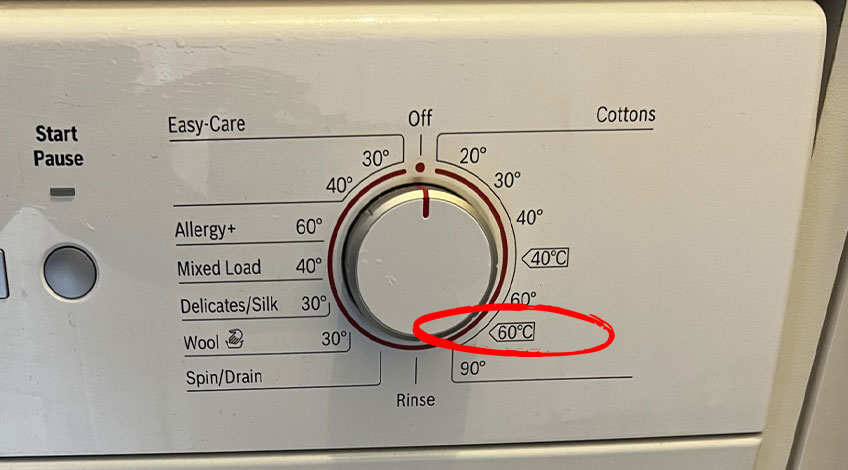
This temperature is also recommended for heavily soiled bedding, including those found in hotels and hospitals. Additionally, it’s a blessing for households with allergy-prone members as it effectively removes allergens.
However, be cautious – not all fabrics can handle the heat. Using hot water on the wrong material may lead to fading, shrinking, or weakening of the fabric’s fibres.
Warm Washes (40°C – 50°C)
Warm washes are a versatile choice suitable for various materials, including cotton, linens, polyester, and synthetic blends.
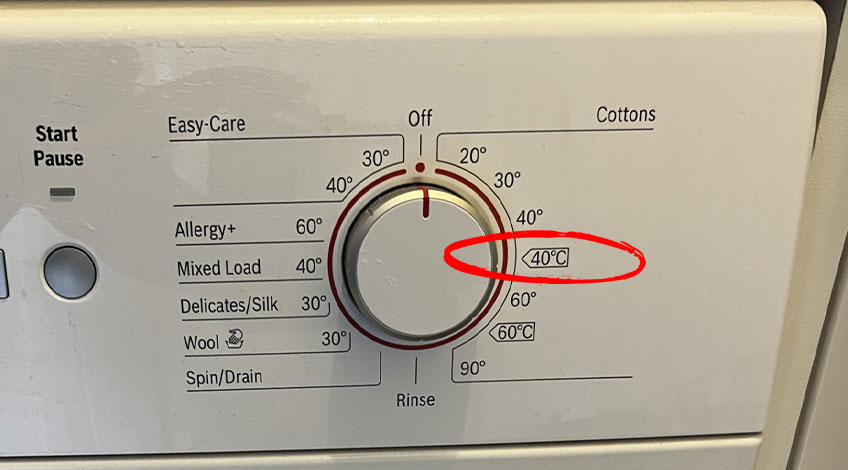
If you’re concerned that hot water might be too harsh for your sheets, a warm wash strikes the right balance between cleaning your fabrics thoroughly without risking damage.
SEE ALSO: What Temperature Is Considered A “Warm Wash”?
Cold Washes (30°C and lower)
Cold washes are best for sheets made of delicate materials like silk, satin, and high-quality microfibre. The lower temperature is gentle on the fabrics, preserving their colour and texture. However, cold washes are less effective at killing germs and dust mites.
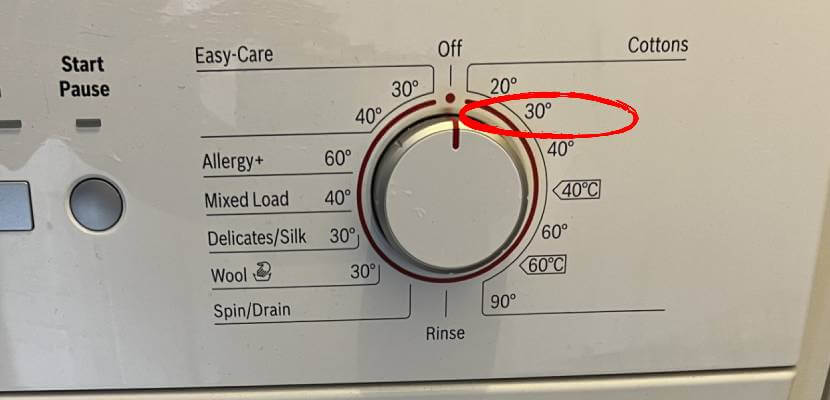
TIP: If you have a stained sheet, make sure to pre-treat stains before putting them in the wash. This way, you’ll have a more efficient laundry session.
What About Tumble Drying And Ironing Sheets?
Before tossing your sheets in the dryer, or subjecting them to an iron’s heat or the sun’s rays, check the care labels.
When it comes to smoothing out wrinkles or creases, steaming is generally a safer option. If the fabric can handle the heat, then iron or steam based on your preference. If not, consider line drying – which is free and environmentally friendly!
Here’s a simple guide to help you:
| Sheet Material | Ironing | Steaming | Air-Drying |
|---|---|---|---|
| Cotton Sheets | Suitable with warm iron; iron when slightly damp for best results. | Can be steamed; helps remove wrinkles. | Suitable for air-drying; shake out before hanging. Avoid direct sunlight. |
| Linen Sheets | Suitable with hot iron; iron when slightly damp. | Can be steamed; ideal for a natural, slightly wrinkled look. | Suitable for air-drying; hang to maintain linen’s natural texture. Avoid direct sunlight. |
| Silk and Satin Sheets | Use a low heat setting; place a cloth between the iron and sheet to avoid direct contact. | Prefer steaming to avoid damage from direct heat. | Suitable for air-drying; lay flat on a clean towel to absorb moisture. Avoid wringing or twisting. |
| Microfibre Sheets | Rarely needed due to resistance to wrinkles. If necessary, use a low heat setting and a cloth or pillowcase as a barrier. | Steaming is an effective option if wrinkles need to be removed. | Suitable for air-drying; hang on a line or use a drying rack. |
| Polyester and Blended Sheets | Suitable with low to medium heat iron; avoid high heat to prevent melting or damage. | Can be safely steamed to remove wrinkles. | Suitable for air-drying; hang on a line or use a drying rack. |
This table serves as a guide, but always follow the manufacturer’s instructions on the care label to avoid damaging your sheets.
Ways To Keep Your Sheets Clean
To ensure a comfortable night’s sleep, keeping your sheets clean should be a priority. Here are some practical tips:
Have A Regular Laundry Schedule
Try to wash your sheets every one or two weeks, particularly if you have allergies or sensitive skin. A regular cleaning schedule will keep those unwelcome guests (like bacteria and dust mites) at bay.
Change Your Sheets Often
Rotating your sheets can extend their lifespan, reducing wear and tear. Instead of relying on just one set, keep a few handy to switch things up.
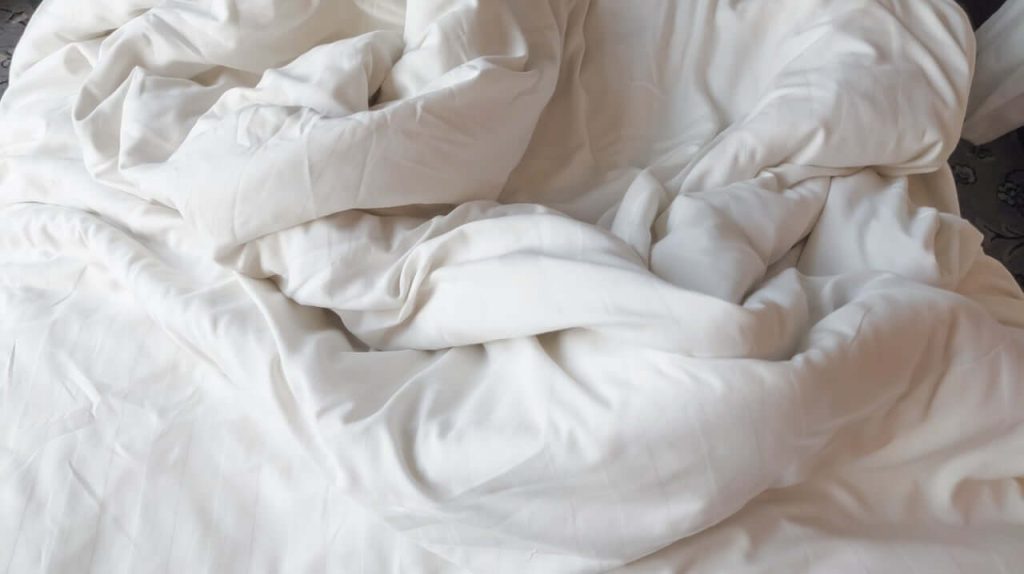
Take A Shower Before Snoozing
Jumping into bed after a shower isn’t just comfy; it’s hygienic. It removes dirt, sweat, and oils from your skin, leaving your sheets cleaner for longer.
Avoid Eating In Bed
Munching on snacks in bed attracts unwanted critters and can lead to allergies or damage to your sheet fabrics.

Clean Your Room
Regular vacuuming in your bedroom reduces dust and allergens that can make their way into your sheets. Keep a clean sleeping environment for better rest.
Keep Your Sheets Clean And Cosy!
So there you have it, the lowdown on washing sheets and keeping them fresh!
By following these tips and choosing the right wash temperature for your sheets, you’ll enjoy a cleaner, more comfortable night’s sleep. So, next time you slide into your fresh, cosy bed, you can rest easy knowing your sheets are as clean as they are comfy.
Do you have any questions? Feel free to ask them below!
Frequently Asked Questions
You should wash bed sheets in hot water (around 60°C) to effectively remove bacteria and germs. However, it depends on the fabric; some may require a warm or cold wash.
To get yellowed sheets white again, try soaking them in a mixture of baking soda and water or using a laundry whitening product. Follow the care instructions on the label.
Bed sheets should be washed every one or two weeks, especially if you have allergies or sensitive skin. Regular cleaning helps keep them fresh.
If you don’t wash your sheets regularly, they can accumulate dirt, sweat, oils, and even bacteria, leading to an unhealthy sleeping environment and potentially causing allergies or skin issues.
Fabric softener is optional for bed sheets. Some people like the added softness and fragrance, while others prefer to avoid it to prevent any buildup on the fabric. It depends on personal preference.
Also, follow us on Pinterest ...

